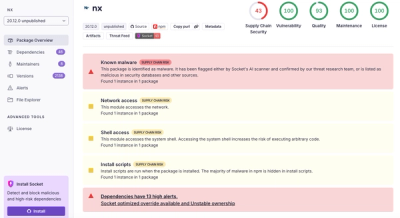
Security News
/Research
Wallet-Draining npm Package Impersonates Nodemailer to Hijack Crypto Transactions
Malicious npm package impersonates Nodemailer and drains wallets by hijacking crypto transactions across multiple blockchains.
openhim-mediator-file-queue
Advanced tools
To install, execute npm install -g openhim-mediator-file-queue
Once installed you will have to manually edit the config files in the location where global npm modules are installed.
~/.nvm/versions/node/v4.1.0/lib/node_modules/openhim-mediator-file-queue/config/usr/local/lib/node_modules/openhim-mediator-file-queue/configYou may add a production.json file to the config folder to override or add any config values.
For development purposes, in order to communicate to the OpenHIM core, since it uses self-signed certificates, execute:
NODE_TLS_REJECT_UNAUTHORIZED=0 npm start
See this visual example of how this work as an OpenHIM mediator. Note the curl commands return instantly but the mediator knows to tell the OpenHIM that these are still processing and updates them after they complete asynchronously.

The file queue simply handles incoming requests, writing the files to a directory on the filesystem, and then processes the queue, sending the files to a configured endpoint. If the file is successfully sent, then the queued file is deleted from the filesystem, otherwise it is moved to an error directory.
Multiple "endpoints" can be configured. Each endpoint handles incoming requests for a specific URL, queues them, and then sends them to another configured URL. An endpoint has a "worker" which is responsible for reading the files from the queue and processing them. Workers can process multiple files in parallel as configured (by default 2 at a time). Workers can be paused/unpaused or repopulated via a RESTlike endpoint. Pausing a worker will stop it from processing files from the queue, but the endpoint will continue accepting requests and writing the files to the queue. Repopulating a worker will cause it to refresh its queue from the files on the filesystem. This is useful when manually adding files to or removing files from the queue.
To pause a queue:
./scripts/pause.sh <worker-name>
To resume a queue:
./scripts/resume.sh <worker-name>
To repopulate a queue:
mv ./error/<worker-name>/* ./queue/<worker-name>/
./scripts/repopulate.sh <worker-name>
Each "endpoint" must have a matching channel and route registered in OpenHIM, for receiving requests and forwarding them to the file queue mediator. When the mediator starts up a new channel will automatically be created/updated based off the settings for the upstream server (where the files will be forwarded to). Note the the channel will be updated each time the endpoint settings are updated.
Please note that the following manual steps might be required to get the File Queue to function correctly:
localhost.file-queue has been created by default for all channels. This role needs to be added to the user account which will be used to push new files onto the queue.Here is an example config for a channel:
{
"name": "File Queue",
"urlPattern": "^/test$",
"status": "enabled",
"routes": [
{
"name": "File queue",
"host": "localhost",
"path": "/test",
"port": "4002",
"secured": false,
"primary": true,
"type": "http"
}
],
"authType": "private",
"allow": [
"file-queue"
]
}
An array of endpoints should be configured in the config file. An endpoint can have the following properties:
name (required) - The name of the endpoint which is used for setting up the RESTlike routes for the worker.path (required) - The path to use for handling incoming requests. A '*' may be used to match any number of characters in a path. E.g. 'this/is/a/test/*'. Note that this path must match the path for the route accepting these requests.url (required) - The URL to send the files to when processing them from the queue.paused - Whether or not the endpoint's worker should be paused by default. This must be a boolean value. Defaults to false.parallel - The number of files that the worker should process in parallel. Defaults to 2.updateTx - Whether or not to attempt to update the OpenHIM transaction once the message has been processed. Defaults to false.forwardMetadata - Whether or not to use the url, headers and HTTP method of the original request when it is forwarded. The path of the original request will be appended to the url property. Defaults to false.Here is an example config file:
{
"port": 4002,
"log_level": "info",
"endpoints": [
{
"name": "test",
"path": "/test",
"url": "http://localhost:9999",
"updateTx": true,
"forwardMetadata": true
}
]
}
FAQs
An async file queue for OpenHIM mediators
The npm package openhim-mediator-file-queue receives a total of 0 weekly downloads. As such, openhim-mediator-file-queue popularity was classified as not popular.
We found that openhim-mediator-file-queue demonstrated a not healthy version release cadence and project activity because the last version was released a year ago. It has 4 open source maintainers collaborating on the project.
Did you know?

Socket for GitHub automatically highlights issues in each pull request and monitors the health of all your open source dependencies. Discover the contents of your packages and block harmful activity before you install or update your dependencies.

Security News
/Research
Malicious npm package impersonates Nodemailer and drains wallets by hijacking crypto transactions across multiple blockchains.

Security News
This episode explores the hard problem of reachability analysis, from static analysis limits to handling dynamic languages and massive dependency trees.

Security News
/Research
Malicious Nx npm versions stole secrets and wallet info using AI CLI tools; Socket’s AI scanner detected the supply chain attack and flagged the malware.